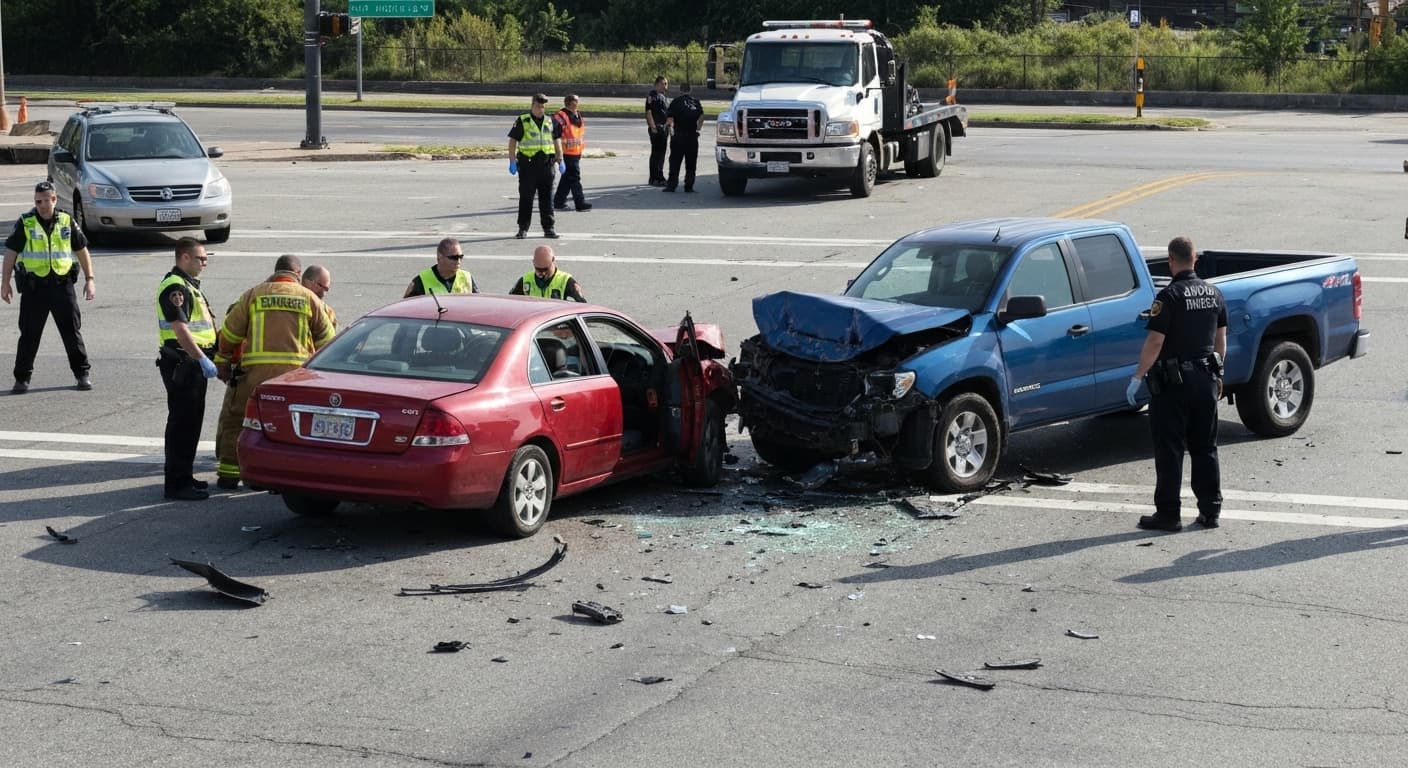
Who is most likely to get into a car accident?
Learn about who is most likely to get into a car accident? and how it affects your legal rights after a car accident. Get expert advice from experienced car accident attorneys.
# Who Is Most Likely to Get Into a Car Accident?
Car accidents can happen to anyone, but statistical analysis reveals clear patterns about which groups of people are most likely to be involved in crashes. Understanding these risk factors is crucial for both personal safety and legal preparedness. If youve been injured in an accident, knowing these demographic patterns can help strengthen your case and demonstrate negligence. Working with an experienced car accident attorney who understands these risk factors can help you receive fair compensation for your injuries, medical bills, lost wages, and pain and suffering.
Understanding Accident Risk Demographics
Vehicle accidents are influenced by a complex combination of behavioral, environmental, and demographic factors. Age, gender, driving experience, and lifestyle choices all play significant roles in determining accident likelihood. Research from organizations like the National Highway Traffic Safety Administration (NHTSA) and the Insurance Institute for Highway Safety (IIHS) provides valuable insights into these patterns, helping both individuals and policymakers develop effective prevention strategies.
The Science of Accident Risk Assessment
Epidemiological Data
- Large-scale statistical analysis of accident reports
- Demographic trend identification and tracking
- Risk factor correlation studies
- Prevention strategy effectiveness evaluation
Behavioral Pattern Analysis
- Driver decision-making process evaluation
- Risk-taking behavior frequency assessment
- Distraction and impairment impact studies
- Learning curve and experience relationship analysis
Age as a Risk Factor
Young Drivers (16-24 Years Old)
Statistical Evidence
- Drivers aged 16-19 are 3 times more likely to crash than older drivers
- Young adults (20-24) account for highest proportion of fatal crashes
- Male teen drivers have twice the accident rate of female teens
- Learning curve impacts contribute to decision-making errors
Age-Related Risk Factors
Inexperience Considerations
- Limited driving practice and exposure
- underdeveloped hazard recognition skills
- Emotional decision-making tendencies
- Overconfidence in abilities
Behavioral Patterns
- Risk-taking behavior frequency
- Peer pressure influence susceptibility
- Distraction source vulnerability
- Speeding and aggressive driving tendencies
Middle-Aged Drivers (25-64 Years Old)
Comparative Safety Assessment
- Generally lowest accident rates among adult groups
- Peak experience and judgment combination period
- Most responsible demographic segment
- Lowest per-mile crash rates
Age-Specific Challenges
Career and Family Balance
- Work-related stress and fatigue accumulation
- Family responsibility driving pressure
- Technology integration challenges
- Emergency situation response patterns
Senior Drivers (65+ Years Old)
Statistical Risk Profile
- Per-mile crash rates increase after age 75
- Account for 18% of traffic fatalities despite being 15% of drivers
- Higher likelihood of severe injury in crashes
- Medical condition impact consideration
Senior-Specific Risk Factors
Physical and Cognitive Changes
- Reaction time slowing with age
- Visual and hearing acuity reduction
- Medication side effect influences
- Multi-tasking capability decline
Health-Related Considerations
- Chronic condition driving impact
- Emergency medical event possibilities
- Mobility limitation accommodation needs
- Adaptive driving strategy requirements
Gender and Accident Risk
Male vs. Female Driver Comparisons
Statistical Gender Differences
- Males involved in 71% of fatal crashes
- Female drivers generally safer driving records
- Men have higher risk-taking behavior rates
- Women more likely to wear seat belts consistently
Gender-Specific Behavior Patterns
Male Driver Tendencies
- Higher speed limit violation rates
- More frequent aggressive driving incidents
- Increased risk-taking maneuver frequency
- Impaired driving higher incidence
Female Driver Characteristics
- More cautious driving approach
- Better adherence to safety practices
- Less frequent distracted driving
- More consistent vehicle maintenance practices
Gender-Based Statistical Analysis
Crash Type Variations
- Males more involved in single-vehicle crashes
- Females more likely in multi-vehicle incidents
- Different time-of-day crash patterns
- Varied environmental condition responses
Geographic and Environmental Risk Factors
Rural vs. Urban Accident Patterns
Location-Based Risk Assessment
- Rural areas: Higher fatality rates due to speed and response time
- Urban areas: More frequent property-damage-only accidents
- Interstate highways: 25% of miles driven, 55% of fatal crashes
- Local streets: Higher accident frequency, lower severity
Environmental Accident Contributors
Rural Driving Challenges
- Higher speed limit allowances
- Emergency response time delays
- Wildlife and debris hazard increases
- Poor road condition prevalence
Urban Driving Complications
- Traffic congestion and flow disruption
- Pedestrian and cyclist interaction increases
- Parking and delivery vehicle conflict points
- Signal and intersection complexity
Regional Accident Variation Analysis
Climate Impact Assessment
- Northern states: Winter weather crash increases
- Southern states: Hurricane and flood-related incidents
- Western states: Mountain driving challenge risks
- Eastern states: Blizzard and ice condition dangers
Time and Day Risk Patterns
Peak Accident Time Analysis
Statistical Time Distribution
- Friday evenings: Highest accident frequency
- Rush hours: 40% of accidents during morning/evening commutes
- Summer months: 25% accident rate increase
- Holiday periods: Significantly elevated risk
Peak Time Risk Factors
Rush Hour Considerations
- Traffic congestion stress accumulation
- Fatigue from early/late schedules
- Multi-tasking pressure increases
- Emergency response challenges
Evening and Night Driving
- Visibility reduction challenges
- Fatigue and drowsiness effects
- Impaired driving likelihood increase
- Reduced law enforcement presence
Seasonal Accident Variations
Seasonal Risk Assessment
- Winter: Ice and snow condition hazards
- Spring: Weather transition unpredictability
- Summer: Vacation and recreation travel increases
- Fall: Leaf accumulation and reduced visibility
Behavioral Risk Categories
Impaired Driving Statistics
Substance Impairment Types
- Alcohol-impaired: 28% of fatal crashes
- Drug-impaired: Rapidly increasing contribution
- Prescription medication: Often overlooked risk factor
- Over-the-counter drug: Fatigue and drowsiness effects
Impaired Driving Demographics
- Young adults: Highest alcohol-impaired crash rates
- Weekend evenings: Peak impairment incident times
- Males: Higher rates of impaired driving arrests
- Commercial drivers: Increased scrutiny and regulation
Distracted Driving Analysis
Distraction Type Categories
- Visual distractions: Eyes off road activities
- Manual distractions: Hands off wheel actions
- Cognitive distractions: Mind off driving tasks
- Auditory distractions: Noise interference effects
Technology Impact Assessment
- Smartphone usage: 23 times crash risk increase
- GPS interaction: Frequent route adjustment needs
- Music and entertainment: Audio system control activities
- Social media engagement: Content interaction distractions
Socioeconomic Risk Indicators
Income and Education Correlations
Economic Status Impacts
- Lower income: Higher uninsured driver rates
- Education level: Safety practice implementation differences
- Employment type: Schedule and fatigue pattern variations
- Vehicle type: Safety feature availability differences
Insurance and Coverage Considerations
- Uninsured drivers: Higher risk profile characteristics
- Underinsured coverage: Settlement limitation implications
- Insurance costs: Risk-based premium variations
- Coverage type: Protection level differences
Medical and Health Risk Factors
Pre-Existing Condition Impacts
Medical Driving Limitations
- Cardiovascular conditions: Emergency event risks
- Neurological disorders: Cognitive and motor skill effects
- Vision and hearing impairments: Sensory input reductions
- Mobility limitations: Adaptive equipment requirement increases
Medication Side Effect Considerations
- Drowsiness and fatigue induction
- Cognitive function impairment
- Motor skill and coordination reduction
- Emergency response capability limitations
Occupant and Vehicle Risk Analysis
Vehicle Type Safety Comparisons
Vehicle Safety Feature Variations
- SUV and truck: Higher rollover risk profiles
- Motorcycle: Most dangerous vehicle category
- Sports cars: Performance vs. safety trade-offs
- Hybrid/electric: Battery and range anxiety distractions
Safety Equipment Implementation
- Seat belt usage: Most effective accident prevention measure
- Air bag deployment: Crash severity reduction capabilities
- Anti-lock brakes: Control maintenance in emergency situations
- Electronic stability: Rollover prevention effectiveness
Legal Implications of Risk Demographics
Liability and Negligence Considerations
Duty of Care Assessment
- Reasonable driver standard application
- Risk awareness requirement analysis
- Safety precaution implementation expectations
- Comparative negligence evaluation factors
Insurance Company Tactics
- Risk profiling utilization in claim handling
- Demographic data application in settlement offers
- Statistical evidence use in defense strategies
- Cost containment through risk segmentation
Personal Injury Claim Strategies
Attorney Utilization Opportunities
- Statistical evidence incorporation in cases
- Risk factor analysis for stronger arguments
- Demographic data application for fair settlement" title="What Happens in Court After a Car Accident Settlement?" class="text-primary hover:underline font-medium">settlements
- Expert testimony integration for causation proof
Prevention and Safety Strategies
Age-Specific Safety Measures
Teen Driver Protection
- Graduated licensing program participation
- Parental supervision and monitoring
- Defensive driving course completion
- Peer pressure resistance training
Senior Driver Adaptations
- Regular vision and hearing screenings
- Medication review with physicians
- Adaptive driving equipment assessment
- Route planning to avoid high-risk areas
Personal Risk Reduction Approaches
Behavioral Safety Practices
- Distracted driving elimination efforts
- Impaired driving complete avoidance
- Speed limit strict compliance
- Following distance maintenance
Vehicle and Equipment Maintenance
- Regular safety system inspections
- Tire condition monitoring and replacement
- Brake system maintenance and testing
- Lighting and signal system verification
Emerging Risk Factors and Trends
Technology Integration Challenges
Vehicle Technology Impacts
- Autonomous driving system adaptation periods
- Infotainment system distraction potentials
- Mobile device integration complications
- Software update and maintenance requirements
Digital Lifestyle Integration
- Real-time navigation system dependencies
- Voice-activated control system learning curves
- Application and software update management
- Cybersecurity and privacy consideration increases
Social and Cultural Trend Analysis
Demographic Shift Implications
- Aging population driving pattern changes
- Urbanization trend traffic pattern modifications
- Technology adoption varying adoption rates
- Economic fluctuation risk profile alterations
Data-Driven Safety Improvements
Research and Policy Development
Accident Data Analysis
- Fatality Analysis Reporting System (FARS) utilization
- Crashworthiness data analysis applications
- Countermeasures effectiveness evaluation
- Prevention strategy refinement processes
Technology and Innovation Integration
- Advanced driver assistance systems (ADAS) development
- Vehicle-to-vehicle (V2V) communication implementations
- Infrastructure safety improvement programs
- Educational campaign effectiveness tracking
Conclusion: Understanding and Mitigating Accident Risks
Statistical analysis reveals clear patterns in who is most likely to be involved in car accidents, with age, gender, time of day, and behavioral factors playing significant roles. The highest-risk groups tend to be young drivers, male drivers, rural residents, and those driving during high-risk time periods. Understanding these risk factors empowers both individuals and policymakers to implement effective prevention strategies.
Regardless of your demographic profile or risk category, preparation is key to protecting yourself and others on the road. If youve been injured in an accident, an experienced car accident attorney can help you navigate the claims process and secure fair compensation for your injuries and losses.
Dont let statistical risk factors determine your accident recovery. Contact a qualified car accident attorney today to discuss your case and learn about your compensation options. Most personal injury attorneys work on contingency fees, meaning you pay nothing unless they win your case. Your safety and financial security depend on understanding these risk factors and taking appropriate protective measures.


